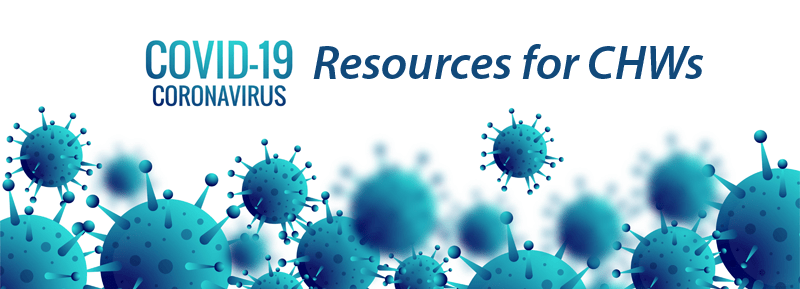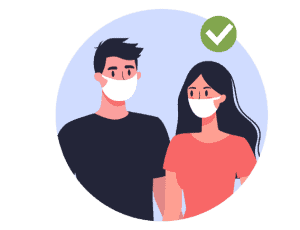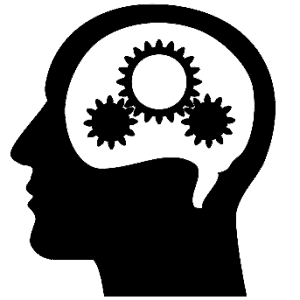
Community health workers (CHWs) are concerned about how the coronavirus impacts their well-being and the people to who are their clients, their families, and community members. CHWs are in a unique position to prevent the spread of the disease COVID-19. They can provide accurate, evidence-based information from trusted sources, help address anxiety and depression, and provide other support to clients because of this public health crisis. CHWTraining has been working to provide information to prevent the spread of COVID-19. Below is a curated list of resources to support CHWs. We’ll continue to update this list with information as the situation progresses and as reliable information is available.
- COVID Vaccine Information for CHWs
- Summer 2021 COVID Guidelines
- General Information About the Coronavirus
- People at a Higher Risk
- Barriers to Health
- Hygiene
- Myths
- Mental Health
- Food Insecurity
- Training Opportunities
- Reopening Safely
COVID vaccine information for CHWs
Must-have information for community health workers supporting COVID initiatives and educating citizens on COVID risks and myths.
- COVID vaccine information for CHWs, CHWTraining
Summer 2021 COVID Guidelines
As of August 2021, the National Institutes of Health (NIH) released new guidelines for post-exposure prophylaxis (PEP) using casirivimab plus imdevimab.
Additionally, the NIH has previously reported the status and FDA recommendations regarding COVID vaccines, PrEP, and PEP.
Regarding coronavirus-related restrictions, each state has released individual guidelines. To find yours, AARP has compiled a handy COVID-19 guidelines list by state and a state-by-state guide regarding mask use.
Event planning platform Northstar Meetings group has also released State-by-State Status Updates on Covid-19 Restrictions.
That said, with COVID-19, we’ve learned that things can change any minute. So stay tuned to local leaders to get the latest, most relevant information.
GENERAL INFORMATION ABOUT THE CORONAVIRUS
News about the coronavirus and the disease caused by it (COVID-19) is quickly changing and can be confusing. These resources provide useful information in plan language to share with clients.
- A simple guide to coronavirus to share with patients and clients, CHWTraining
- What healthcare workers should know about COVID-19, CDC
- Coronavirus Resource Center, Harvard Medical School
- Specific phrases & word choices that can be helpful when dealing with COVID19, Serious Illness Conversations
Latest COVID-19 Research Studies, The Lancet
“To assist health workers and researchers working under challenging conditions to bring this outbreak to a close, The Lancet has created a Coronavirus Resource Centre. This resource brings together new 2019 novel coronavirus disease (COVID-19) content from across The Lancet journals as it is published.”
Guidelines for Frontline Workers, Unicef
UNICEF provides CHWs with helpful guidelines and reports regarding various aspects of the COVID-19 crisis including special considerations for many key health areas including nutrition, HIV/AIDS, and hygiene.
Managing COVID-19 in Healthcare Facilities, WHO
To optimize the safety and efficiency of healthcare settings, specific strategies and considerations have been developed to help CHWs deal with the pandemic. Tactics for infection control, PPE supply, and staffing shortages can improve how practitioners deal with the current surge in patient numbers and hospital services. These management methods will not only improve the experience for healthcare workers but for patients as well.
Masks
How to Select, Wear, and Clean Your Mask, John Hopkins Medicine
Masks need to be correctly worn in order to prevent the spread of particles that carry the virus. The best type of mask is a multi-layered cloth mask or a disposable surgical mask (N95s are not recommended due to their shortage for healthcare workers) that covers the mouth and nose without gaps. Reuse of disposable masks is not recommended, however, cloth masks may be washed and reused.

The best practice is to wash your hands before and after putting on your mask. You should not touch your mask while wearing it, as it could potentially be contaminated with the virus and could make you sick. To remove the mask, carefully untie or release the elastic loops from your ears or head, fold the mask using these loops, and store in a clean container such as a paper bag. Keep the mask away from other belongings and wash your hands after handling. Do not store multiple masks in the same container.
PEOPLE AT A HIGHER RISK
Anyone can contract the disease and may become seriously sick, but some people are at a higher risk of having complications or death from COVID-19. These include such conditions as asthma, diabetes, heart disease, lung disease, diabetes, and other underlying conditions.
What’s New for Diabetes and Prediabetes, CHWTraining
CHWs can advise on what diabetes is, how to interpret blood sugar levels, share healthy eating ideas and recipes, and give ideas for physical activity. They can also connect clients to professionals who can provide more support beyond a physical, such as dental workers and dietitians. They can also help vulnerable and minority communities who have statistically worse health outcomes from diabetes.
COVID-19 and Asthma, CHWTraining
Asthma is one of the underlying health conditions that can increase people’s risk for serious case of COVID-19, the disease caused by the coronavirus. This doesn’t mean they’re more likely to get an infection, but they are more likely to have worse outcomes if they become sick with COVID-19.
Hospitals are a bad place to be right now. People with lung conditions are more frequently admitted to hospitals because of their illnesses.
The best thing frontline health workers can do is help people stay home, keep a safe distance from others, and avoid getting sick in the first place. They should stay connected with their healthcare providers about any symptom changes. And, of course, follow the asthma action plan.
COVID-19 and Heart Disease, ACC
Managing heart disease patients during the COVID-19 pandemic can be tricky due to the higher mortality risk of this group. CHWs need to continue following up with such patients to ensure their drug compliance and to reduce risk of complications. They can take special precautions to prevent occurrence of major cardiovascular events like thrombosis and infarction. Further considerations are needed for elderly patients and essentials workers with a history of heart disease.
BARRIERS TO HEALTH
The COVID-19 pandemic has shed light on inequalities and intersections of health. Many organizations are studying how racism and inequality deepens the divide in treatment and healthcare in diverse communities. CHWs play a unique role in that they work to shorten or close this gap. Staying informed on how you can make an impact not only benefits you, but also your community with the work you can do with your new knowledge.
Systemic Racism & Healthcare, COVID & Treatment, NICHM
The National Institute for Health Care Management (NICHM) creates detailed infographics to further explain these impacts and how they have changed the roles of healthcare workers.
HYGIENE

Handwashing (and moisturizing) in the age of COVID-19, Harvard Health Publishing
Frequent handwashing is important to preventing the spread of the virus. It is important to wash every part of the hand, even the wrist, and to pat your hands dry with a clean towel. If soap and water are not available, alcohol-based hand sanitizers with at least 60% alcohol can be substituted when appropriately used.
For healthcare providers, the CDC has specific guidance on hand hygiene and PPE use.
Coronavirus Disease 2019 vs. the Flu, John Hopkins Medicine
Stay home if you feel sick or have any symptoms and be sure to cover your cough and sneeze with your elbow. Schedule an appointment to get tested for COVID-19 with a local provider if you have concerns about your symptoms.
If you are unsure if your symptoms are for the flu, COVID, or a common cold, see the diagram posted by the CDC and call to discuss with your provider.
The Ultimate Guide to Cleaning and Disinfecting Surfaces in COVID-19 Times, Everyday Health
Depending on the frequency of contact with others, you may need to clean surfaces you come in contact with daily. Use antibacterial sprays and wipes and dispose of them properly after cleaning. The virus does not survive as long on clothing and fabrics, so these materials should be cleaned when in contact with someone who is sick or when otherwise necessary. Follow the instructions on the product tag for proper cleaning.
For more information on different surfaces and how frequently they need to be cleaned, see the guide presented by Everyday Health.
MYTHS
COVID Myths Busted, WHO
It’s important for CHWs to spread awareness and minimize misinformation about COVID-19. Rumors about the virus including its method of transmission, life span, treatment, and symptoms can cause unnecessary panic. Healthcare workers are responsible for sharing scientific facts to help manage the crisis. Creating flyers, advising patients during check-ups and consultations, and using word of mouth to circulate COVID-19 facts are recommended.
More Than Just an Infection, World Psychiatric Association
COVID-19 is not only a novel virus but a novel worldwide phenomenon. Therefore, it is crucial to address the psychological implications of the pandemic. CHWs “know it is not only the physical effects of COVID-19 that are detrimental for society, but also the mental health effects. As well as supporting people with mental ill health, supporting everybody’s mental health is key.”

5 Common COVID-19 Myths, Busted, The Cleveland Clinic
Heat and climate are not protections against the coronavirus. What other ideas about COVID-19 are untrue? Keeping up with the most recent studies and information is crucial to determining fact from fiction. Reviewing information from credible sources such as the CDC, WHO, health departments and health systems is a great way to stay up to date.
The Cleveland Clinic offers explanations for 5 common myths and has a database of other resources to help with public health education.
MENTAL HEALTH
10 Signs You Need to Make a Behavioral Health Referral, CHWTraining
Chronic stress can come from many sources such as poverty, long-term sickness, or domestic violence, in addition to a global pandemic. Stress has a serious effect on a person’s overall wellness. It can increase the risk of heart disease and strokes. It can increase depression, anxiety, and more serious mental illnesses—all associated with heart disease and a lower immune system. Stress can also lead people to unhealthy choices with food and substances. Find out what to do when someone needs a behavioral health referral.
COVID-19 Resource and Information Guide, National Alliance on Mental Illness
NAMI released the NAMI COVID-19 Resource and Information Guide to answer frequently asked questions regarding the intersection between Coronavirus, or COVID-19, and people affected by mental illness, their caregivers and loved ones. The guide features FAQs on a variety of topics from managing anxiety and social isolation to accessing health care and medications.
Also available in Spanish.
Mental health and psychosocial considerations during the COVID-19 outbreak, WHO
“The considerations presented in this document have been developed by the WHO Department of Mental Health and Substance Use as a series of messages that can be used in communications to support mental and psychosocial well-being in different target groups during the outbreak.”
How to Deal with Coronavirus Burnout and Pandemic Fatigue, Johns Hopkins Medicine
Here are some general strategies that workers and employers can use to manage workplace fatigue and work safely.
FOOD INSECURITY
The Impact of COVID-19 on Food Demand and Supply, Food and Agriculture Organization of the United Nations
How does COVID-19 affect the food market in terms of demand and supply? Which groups are at high risk of food insecurity during this pandemic? How will food prices change the lives of both farmers and consumers? The Food and Agriculture Organization (FAO) creates updated resources for the public including Q&A sheets and policy briefs to evaluate the crisis and offer solutions.
Need Help? Find Food., Feeding America
The Feeding America network of 200 food banks and 60,000 food pantries and meal programs serve virtually every community in all 50 states, Washington, D.C. and Puerto Rico. Food is free without any expectation of donation or repayment. Search by zip code or state using the food bank locator and contact the food bank that serves your area.
TRAINING OPPORTUNITIES
Burnout Prevention for CHW Supervisors, CHWTraining
Supporting a community health team with limited resources can be a daunting task right now. What self-care strategies do they need? How can they control stress and enjoy their work more? As a supervisor or program manager, how do you spot signs of burnout and compassion fatigue earlier? You can help your team improve their personal and professional lives. Improve your team’s mental wellness by identifying early signs that an employee is at risk for depression, anxiety, or secondary trauma.ou can help your team improve their personal and professional lives.
Making Contact: A Training for COVID-19 Contact Tracers, ASTHO
Introductory online course for entry-level COVID-19 contact tracers, for use by health agencies in rapid training of new contact tracers. The training will be augmented by state/local specific training required to orient individuals to jurisdiction-specific protocols. This training focuses on building knowledge for remote contact tracing; a subsequent release will include a module on field services.
COVID-19 & Diabetes: Examining the impact of health disparities in a time of crisis, ADA
“Learn how inequalities in factors like income, food access, health care access, housing, transportation and more impact minority populations disproportionately affected by diabetes during this pandemic. In addition, learn about ADA’s Advocacy efforts to address these upstream factors contributing to health as they relate to diabetes and COVID-19, and how you can raise your voice in support of ADA’s vital health equity work.”
Webinars & Briefings, NICHM
NICHM provides frequent webinars to stay in touch with the most recent data and analyses of barriers to health.
REOPENING SAFELY
Protect Yourself When Using Public Transportation, CDC
As schools, businesses, and community organizations begin providing services, consider ways that you can protect yourself and slow the spread of COVID-19 when using transportation. When you consider the following options, think about what is feasible, practical, and acceptable to you and meets your needs. Also see CDC’s tips for how to stay safe while running errands.
Suggestions for Youth and Summer Camps, CDC
CDC offers the following suggestions for ways in which camp administrators can help protect campers, staff, and communities, and prevent the spread of COVID-19.
Resuming Business Toolkit, CDC
This toolkit is designed to assist employers in slowing the spread of COVID-19 and lowering the impact in their workplace when reintegrating employees into non-healthcare business settings.
Path Forward, U.S. Chamber of Commerce Foundation
This series of presentations is designed to help business and community leaders find the answers they need to execute a responsible reopening strategy and plan for a post-pandemic world.
COVID-19 Standards, OSHA
The Occupational Safety and Health Administration (OSHA) creates standards for keeping both healthcare and non-healthcare workers safe during the pandemic. See this page for more information on your rights and responsibilities and the safety requirements of your workplace.
This post was updated August 17, 2021. It originally appeared May 11 2020
Background vector created by Harryarts – www.freepik.com
